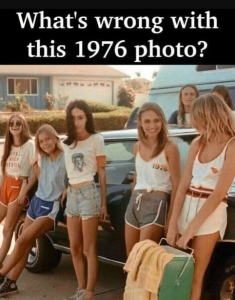 Why Friendships Were So Much Stronger in the ’70s: A Journey Back to Simpler Times
Why Friendships Were So Much Stronger in the ’70s: A Journey Back to Simpler Times
In an age of instant messages, read receipts, and social media “likes,” many find themselves nostalgic for something more real — something that felt warmer, deeper, and more lasting. Ask anyone who grew up during the 1970s, and they’ll tell you: friendships back then were different. Stronger. More authentic. Less distracted.
But what made friendships in the ’70s so uniquely powerful? Let’s take a journey back in time to explore why bonds were tighter, trust ran deeper, and friendships often lasted a lifetime.
1. No Phones, No Filters — Just Presence
In the 1970s, there were no smartphones, no TikTok scrolls, and no group chats. If you wanted to talk to someone, you picked up a landline — and if they weren’t home, you waited. That might sound inconvenient to us today, but it actually fostered patience, anticipation, and intentionality.
When friends hung out, they were fully present. No one was glancing at notifications or checking how many people liked their latest photo. Conversations were face-to-face, uninterrupted, and heartfelt. You listened. You laughed. You looked each other in the eye.
This unfiltered presence built trust and depth — the foundation of every great friendship.
2. Time Together Was Time Well Spent
Back then, “hanging out” didn’t mean jumping on a video call or sending a meme. It meant real-world adventures: riding bikes through neighborhoods, playing music on record players, lounging on porches, walking to the local diner, or passing time at the community swimming pool.
Because there weren’t endless digital distractions, friendships were activity-based. You did things together. You built go-karts, started garage bands, or just laid in the grass and talked about life. These simple experiences created shared memories that couldn’t be replaced or replayed — only remembered.
Friendships were rooted in experiences, not exchanges.
3. Handwritten Notes and Phone Calls Had Weight
In a world without texts or DMs, communication between friends was rare and meaningful. A phone call after school meant you truly wanted to talk. A handwritten note passed in class felt like a treasure.
Kids kept boxes of notes, letters, and drawings. These weren’t just scribbles — they were tokens of loyalty and affection. Friends made mixed tapes for each other. Decorated lockers on birthdays. Waited for hours in line at payphones just to hear a voice.
Every small gesture felt bigger because it required effort — and that effort created deeper emotional bonds.
4. Loyalty Meant Something
The ‘70s were built on loyalty. You stuck with your friends, even if they messed up. You defended them in schoolyard conflicts. If someone talked behind their back, you didn’t join in — you shut it down.
It was a time when your best friend’s battles were your battles, and your wins were their wins. This wasn’t just cultural — it was relational survival. You didn’t have thousands of online acquaintances. You had your crew, and you stuck together.
Trust was built not by how many times someone liked your post, but by how often they showed up when it mattered.
5. Shared Struggles Brought People Closer
The ’70s weren’t all peace and disco. The world was full of change — the aftermath of Vietnam, rising inflation, civil rights shifts, and societal unrest. But for many young people, these challenges brought them closer.
Whether you were protesting something, listening to Bob Dylan, or just surviving strict parents, your friends were your lifeline. You navigated the complexities of adolescence without Google, without mental health apps, without group therapy.
So you leaned on each other.
Friends were your therapists, co-conspirators, and secret-keepers — long before “safe spaces” were a cultural concept, they created them for each other.
6. Communities Were Smaller, and So Was the World
Back then, most people grew up in tight-knit communities. You walked to school together. Went to the same church, the same grocery store, the same park. There was no global internet to distract you — just your neighborhood.
You knew your friend’s parents. Their siblings. What snacks they had in their kitchen. And when something went wrong in your world, your friends weren’t miles away — they were across the street.
This proximity bred intimacy. You didn’t just know your friends — you knew them.
7. Less Pressure to Perform
Today’s youth navigate an exhausting performance culture. Every photo, caption, or status update is a chance to be judged or praised. But in the ’70s, there was no “brand” to maintain.
You could be goofy, awkward, weird — and no one was broadcasting it to the world. You didn’t need perfect hair or trendy clothes to matter. Your value came from your vibe, not your visibility.
This freedom meant friendships were based on who you were, not how you appeared. That authenticity made bonds stronger and more accepting.
8. Fewer Friends, Deeper Friendships
With no followers or friend counts, friendships in the ’70s weren’t about quantity. You didn’t need 200 people to wish you happy birthday — you needed 2 or 3 who’d show up at your door with a slice of cake.
Smaller circles meant bigger loyalty. There wasn’t room for fake connections. You knew who your people were — and they knew you.
And when conflicts happened, you didn’t ghost each other. You worked it out, face to face. That conflict resolution built resilience, forgiveness, and growth.
9. Nostalgia Isn’t Just Sentiment — It’s Science
Research today shows that digital communication — though fast — lacks the emotional depth of in-person connection. Physical touch, eye contact, and voice tone all trigger oxytocin — the “bonding hormone.”
The friendships of the ’70s thrived because they were rooted in real human interaction, the kind that builds lasting neurological connections. So when people say “friendships were stronger back then,” they’re not just being sentimental — they’re remembering a different kind of social wiring.
10. Memories Made Without Cameras Last Longer
In the ’70s, few people carried cameras around. Photos were rare, special, and often reserved for big events. That meant most moments with friends weren’t documented — they were simply felt.
You didn’t live to capture a memory — you just lived it.
And maybe that’s the real magic. The strength of ’70s friendships wasn’t just in the time spent — it was in the unspoken, the unseen, the unforgettable.
Conclusion: A Lesson for Today
While we can’t go back in time, there’s something we can learn from those simpler, slower days. In a world chasing followers and viral moments, we’re still wired for real friendship — the kind that shows up, listens, forgives, laughs, and stays.
Maybe it’s time we put our phones down, knock on a door, and sit on a porch for a while — just like they did in the ’70s.
Because what made friendships stronger back then wasn’t magic.
It was presence, patience, and purpose — and we can bring that back, one real connection at a time
